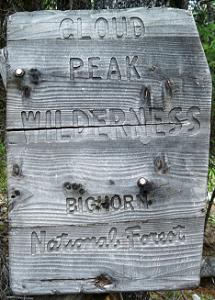Any Wilderness Will Do
 This is the Cloud Peak Wilderness boundary marker, but it could be any wilderness area. We have special regulations and laws when you set foot past that sign. It's necessary because many people still do not appreciate the value of preserving wild spaces.
This is the Cloud Peak Wilderness boundary marker, but it could be any wilderness area. We have special regulations and laws when you set foot past that sign. It's necessary because many people still do not appreciate the value of preserving wild spaces.I'm a pretty strong advocate for the concept of Leave No Trace even though the it's an impossible goal - we always leave some trace as we go through life. I guess I prefer the term Minimize Impact better since I can be successful at that.
Whatever you call it, I think it's important that the Boy Scouts put more effort into integrating and embracing LNT principles. It now appears on many pages of the latest Scout Handbook and is required knowledge and practice for advancing to First Class. But, I wonder how much it is actually promoted and checked for when those requirements are signed off.
Some people feel that Leave No Trace is just for wilderness areas and it's ok to hack, slash, burn, and trample BSA camps. BSA camps that I've visited are great places, but they get a lot of traffic. And, a couple uneducated scouts with a saw, ax, or shovel can do a lot of damage - damage that visitors will see for years.
These BSA camps are perfect training grounds for teaching and practicing how to minimize impact so that treks to Philmont, Northern Tier, or other wilderness areas are demonstrations of skill rather than learning of skill. They aren't wilderness areas, but they'll do just fine for learning. It's not appropriate to take youth to the wilds and then start explaining what Leave No Trace is and how to do it. That should have been done since they first joined the troop so they're ready to make the right environmental decisions on treks.
Making Leave No Trace happen depends highly on the adult leaders and traditions of a troop. If a troop has always had campfires, bathed in streams, tossed out or buried food waste, set up tents on the softest grass, ... then there is a big culture shift needed before they participate in a high adventure trek.
On the other hand, scouts that are used to using backpacking stoves, compressing and carrying out garbage, looking for durable spots for tents and kitchen, digging catholes, and the like will more likely have little problem completing a trek with small sign of their passing.
Our troop is fortunate to have a Leave No Trace workshop offered at least twice a year. From this, we've got a majority of scouts and adults trained in the principles. Having the knowledge makes the practices easier to incorporate into weekend campouts. Scouts look for good tent locations, stay on trails, are careful with food and pick up what they drop, strain wash water, just as a matter of course. Of course, they aren't perfect about it but we practice it and by the time they are old enough to go on any wilderness outing, they have the skills.
Please consider how your troop impacts the wilds. Check with your Council Outdoor Ethics Advocate to arrange a Leave No Trace workshop or see if you can get a scout and an adult to attend a Leave No Trace Trainer class. If you have an LNT Trainer, then he can present workshops to your troop, Webelos dens, Girl Scout troops, and any other groups heading outdoors. A Leave No Trace workshop isn't sitting and learning - it should be very interactive, hands-on activities that support the seven principles and I think they are a lot of fun, whether participating or presenting.
Scout On
Posted: 16:56 08-16-2010 515
Comment or Question about this page:
Scouting 2025 - Ask a Question - Add Content
Just for Fun: Socializing merit badge




This site is not officially associated with Scouting America
Find more Scouting Resources at www.BoyScoutTrail.com



Follow Me, Scouts
Recent Comments